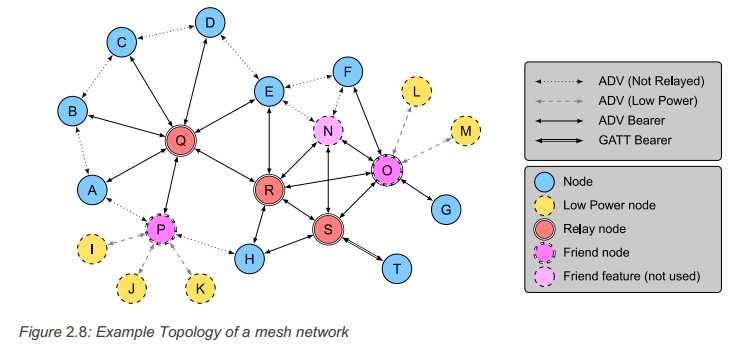标签:轮询 end sage mic must ESS forward tis into
Nodes that support the various features described above can be formed into a mesh network. An illustration of a mesh network is shown in Figure 2.8 below
支持上述各种特性的节点可以形成网状网络。网格网络的示意图如下图2.8所示

Figure 2.8 shows three Relay nodes: Q, R, and S. The three nodes that support the Friend feature are N,O, and P, however N does not have any friendships; therefore only O and P are Friend nodes. There are five Low Power nodes: I, J, K, L, and M. Nodes I, J, and K have P as their friend, while L and M have O as their friend. Node T is only connected to the mesh network using a GATT bearer; therefore S must relay all messages to and from T
图2.8显示了三个中继节点:Q、R和s。支持朋友功能的三个节点是N、O和P,而N没有任何朋友关系;因此,只有O和P是朋友节点。低次节点有5个:I、J、K、L和M。节点I、J和K以P为友,而L和M以O为友。节点T仅使用GATT承载器连接到MESH网络;因此,S必须将所有消息转发到T,并且转发从T收到的消息。
For example, if a message is to be sent from T to L, then T will send the message to node S using the GATT bearer. Node S will retransmit this message using the advertising bearer. Nodes H, R, N, and O are within radio range of node S; therefore they will receive this message. Node O, being the friend of node L will store the message, and if the message was a segmented message, node O will respond with an acknowledgment at the lower transport layer. Sometime later, L will poll node O to check for new messages, such that O will forward the message originally sent by T to L.
例如,如果一条消息要从T发送到L,那么T将使用GATT承载器将消息发送到节点S。节点S将使用广播承载器重新传输此消息。节点H、R、N、O在节点S无线电范围内;因此,他们将收到这个消息。节点O作为节点L的朋友将存储消息,如果消息是分段消息,节点O将在底层传输层响应确认。稍后,L将轮询节点O以检查新消息,以便O将T最初发送的消息转发给L。
标签:轮询 end sage mic must ESS forward tis into
原文地址:https://www.cnblogs.com/gancai/p/12283878.html